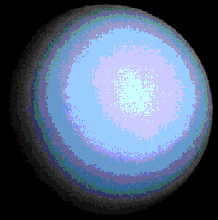This is an image of Uranus.
Click on image for full size
NASA
An Overview of Uranus' Atmosphere
The plain aquamarine face of Uranus confirms the fact that Uranus is covered with clouds. The sameness of the planet's appearance shows that the planet's atmosphere is mostly composed of one thing, methane. The planet appears to be blue-green because the methane gas of the atmosphere traps red light and does not allow that color to escape. Beside clouds of methane crystals low in the atmosphere, smog, composed of ethane (the same product that can provide fuel for automobiles), is also present high in the atmosphere. The cloud particles constantly recycle themselves, first creating then destroying the heaviest crystals. This is an indication that Uranus' atmosphere is still evolving from its formation out of the solar nebula. Because Uranus lies on its side, Uranus has very strange seasons. Motions in the cloud patterns indicate that, like Jupiter and Saturn, the basic weather of Uranus can be described as a striped pattern of winds. This means that, even though the pattern is hard to see, Uranus is striped, just like Jupiter and Saturn.
You might also be interested in:
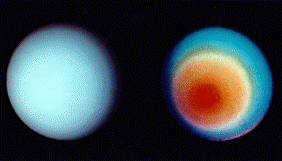
The clouds of Uranus, composed of methane crystals, are found very low in the atmosphere, and are difficult to see below the smog haze s of the planet. False color is used, in the image of Uranus to the
...more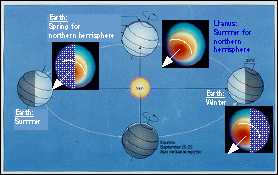
As a planet orbits the sun, if its rotation axis is tilted, the portion that is tilted toward the sun will receive an excess of sunlight and energy (summer), while the hemisphere which is tilted away
...more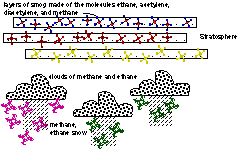
Besides methane, Uranus' atmosphere contains even more complex molecules such as ethane gas. (These gases are similar to the exhaust gases that come out of cars on earth). These molecules form layers of
...more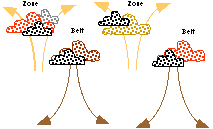
On Uranus, as on Jupiter, the winds in the belts and zones blow first in one direction, then in the opposite direction. Wind blows east in a belt, and west in a zone. The clouds rise up in a belt, and
...more
The clouds on Uranus, like Jupiter, are divided into belts and zones. On Uranus the belts and zones are hard to find. The left picture shows the north pole of Uranus. In this picture only the smog of
...more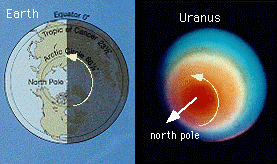
In this picture, the Earth and Uranus are both viewed from the top. In the view of the Earth, the sun is shining from the left, and part of the north pole is in daylight and part of the north pole is in
...more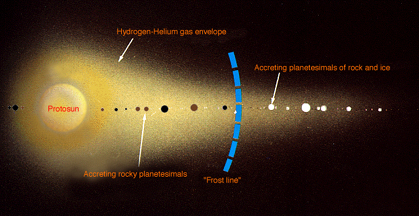
The position of the planets in the solar nebula greatly affected their 1. size and 2. composition. This is because of the effect of how cold it was in the nebula. 1. The nebula was a lot warmer close to
...more


